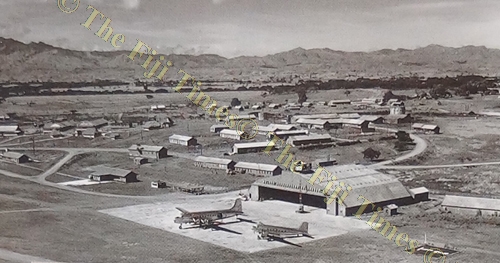LIKE a number of places in the country, Nadi has an interesting story when it comes to how the Jet Set Town was named.
So says Robert “Bob” Kennedy, a man with an unflinching attachment to the district, ever since his Scottish forefathers settled in the town.
“Early on, the Indian farmers came across from Ba and Rakiraki and the district officer would go around and get their names and details,” he shared.
“When they were asked where they lived, they did not know the Fijian word for river so they said nadee, which is the Hindi word for river. So the derivative of the name stuck.”
Nadi, home to the Kennedy family, was in for a massive change when the Pacific War became imminent and Imperial Japan dominance caused the West to worry.
The decision to turn a part of Nadi into an airfield came at great personal cost to the Kennedy clan.
“We owned several hundred acres of land which was taken during the war and no compensation was given.
“We were never paid for it and in fact, we had to get out of the house and go to New Zealand because we were scared the Japanese would bomb Nadi. So we went by boat to New Zealand.”
Nadi being declared the main aerodrome site in Fiji was no coincidence.
Weather was deemed better and chances of poor visibility or low cloud were rare in Nadi.
Thus, three grass airfields were completed by 1940. Over in Nausori, there were plans to construct a single narrow strip.
According to written accounts from Rowland Gouch Michael “Mike” Varley, the first chief executive of the Civil Aviation Authority of Fiji (CAAF), Nadi was selected as an airfield site as it was relatively flat.
“The construction of a small grass air base at Nadi suitable for use by DH-89 Rapide aircrafts was completed by March, 1941,” Mr Varley writes.
“However, while Nadi was still under construction, ‘Unit 20’ of the Royal New Zealand Air Force (RNZAF) consisting of four aircrafts arrived in November, 1940. It eventually became the number four reconnaissance squadron of the RNZAF in the South Pacific area.”
In October, 1941, General Douglas MacArthur, then US Commander in the Philippines, directed that new airfields should be constructed in the South Pacific to enable B17 bombers to be ferried to the Philippines and avoid Japanese mandated territories in the West Pacific According to Mr Varley, this was two months before the Japanese attack on Pearl Harbour.
At that time, about 35 B17 aircrafts were already at Clarke Field. This was the main United States Army Air Forces (USAAF) air base in the Philippines.
“A civil engineering firm of Sverdrup and Parcel from St Louis, US was asked to carry out a survey for such a route.
“After visiting Honolulu and a number of islands in the South Pacific, including Fiji, Mr Sverdrup attended the 2nd British Commonwealth Defence meeting in Wellington, New Zealand in November, 1941.”
In due time, delegates reached an agreement for the United States to finance the construction of two 7000 foot long runways at Nadi by a New Zealand firm, the Southern Cross Construction Company.
The total cost for this was billed at $US1 million ($F2.11m). Records from CAAF indicate the job was given to the New Zealand Public Works Department.
Through its Civil Construction Unit, Arnold Downer, a civil engineer heading the New Zealand company Downers, was tasked with the project.
Construction equipment was then commandeered from all the Public Works districts in New Zealand, as well as men.
Inter-island ferry Wahine was enlisted into service, receiving a one-hour notice to transport everything to Fiji.
The first load of construction equipment from New Zealand arrived into Fiji on November 30, 1941.
The project was estimated to reach completion by 1942.
However, the Japanese bombing of Pearl Harbour on December 7, 1941, had put pressure on the contractors to redouble their efforts.
With this in mind, the first two partially completed runways were tested on January 6, 1942, by a Hudson.
A few days later, three Boeing B-17s arrived from Canton Island and landed on the southern half of the then unsealed runway.
This marked Nadi’s emergence as an international airport.
According to Mr Varley, Clark Field, the main USAAF bomber base in the Philippines, had fallen to the Japanese on December 29, 1941.
The Nadi base was at this point taken over by the US Military Air Transport Service and it served as the main World War II base in the South West Pacific for next five years.
It was in February, 1946, that a British Commonwealth Conference would be held where a South Pacific Air Transport Council (SPATC) was formed.
This council would go on to run Nadi Airport and control of Nadi Airport was handed over to New Zealand in December, 1946.
Upon gaining independence in 1970, the Fijian Government began participating in the organisation of Nadi Airport, with full control being handed over in 1979.
- Next week: Learn more about Nausori International Airport, considered the gateway to the Central Division and the nation’s capital.



